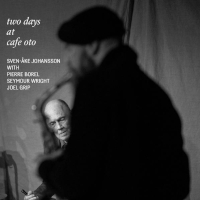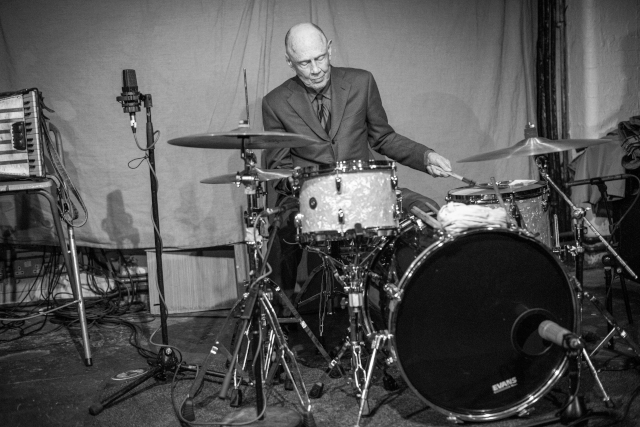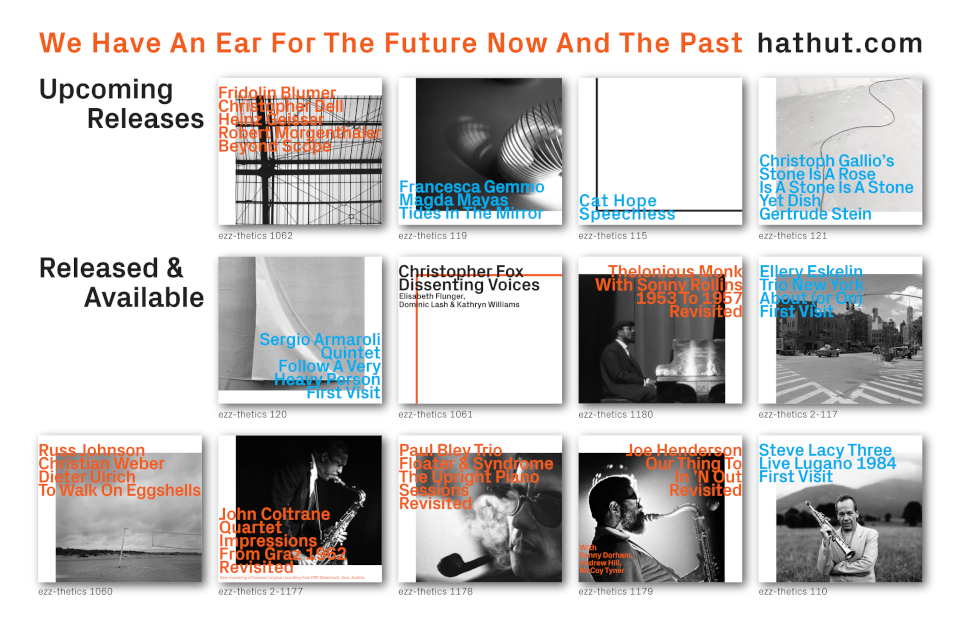Moment's Notice
Reviews of Recent Media
Sven-Åke Johansson + Pierre Borel + Seymour Wright + Joel Grip
two days at cafe oto
OTOROKU ROKU042CD

Sven-Åke Johansson is seldom mentioned in the same, first breath with Peter Brötzmann and others in the discourse about the dawn of European free music. Nor is Johansson foregrounded like Han Bennink and Tony Oxley in the narrative about the evolution of the role of percussion in free music. Johansson’s is a strange relegation to a minor historical role.
It is harder to explain why he is the odd man out in the creation narrative of European improvised music than the percussion discussion. Johansson simply did not employ an array of objects similar to those portrayed on the cover of Oxley’s Ichnos. Although Bennink and Pierre Favre were first to record solo albums, Johansson stuck with a basic kit throughout Schlingerland/dynamische Schwingungen, recorded in 1972. His reliance on the straight-forward development of precisely executed, rudiments-based materials did not dispel as sarcasm Johansson’s quip at the time that he was influenced by Sunny Murray and Shelly Manne.
There are market reasons for Johansson’s secondary status. He did not cultivate an audience in the US like Brötzmann or Evan Parker, so he is all but absent in Americans’ telling of the tale, the most notable exception being the five-page discussion in Mike Heffley’s nearly 400-page Northern Sun/Southern Moon: Europe’s Reinvention of Jazz (2005; Yale University Press). Unlike Brötzmann, who developed a branding synergy between his music and visual art through his album cover designs, Johansson’s activities as poet, author, and visual artist were free-standing and remained off the radar of all but the most forensic free music chroniclers.
There are also aesthetic reasons. He was not only an improviser, but also a composer of operas, lieders, jazz tunes, and solo piano pieces. Johansson’s “Vom Gleichwertigen und Ungleichwertigen,” included on pianist Steffen Schleiremacher’s Enfants Terribles (1998; hat[now]ART) with works by Tom Johnson and John Zorn, was characterized by annotator Art Lange as “mirror[ing] Satie’s simplified patterns, childish demeanor, and labyrinthine, seemingly endless and seemingly illogical chord modulations.” Hardly descriptors of the assaultive energy of Machine Gun.
However, Johansson’s sensibility was not merely facile. He brought an unsparing rigor to his various pursuits until his passing in June, one that is front and center on two days at cafe oto. His short sleeve note is insightful in this regard: “The seemingly irreverent approach to the instruments, the repetitive repeats of certain motifs: ‘institutional music’ could be something that comes to mind for the listener. The inmate, free of all musical convention, behaving childishly, almost manically. The result is a polyphonic counterpoint that comes close to falling apart and leaves the impression of being something new.”

Sven-Åke Johansson © 2025 Dawid Laskowski
There is a semblance of teetering, of being on the edge of disintegration, that permeates much of Johansson’s work with bassist Joel Grip and alto saxophonists Pierre Borel and Seymour Wright on this 2-CD collection. Johansson is the magneto of this uncertainty, his drumming having just enough gravity to keep his cohorts in occasionally wobbly orbits, but without the flares that set an improvisation ablaze. There is none of the prolonged ecstatic delirium that Grip and Wright are parties to with أحمد [Ahmed]. Even Wright’s singular determination to wring every possible texture and inflection from a single pitch is not enough to incite Johansson to unleash the thunder that made his first solo album, his early work with Brötzmann and Alexander von Schlippenbach, and his historicization of early free jazz with his late ‘90s quintet, memorable.
Wright and Borel, Johansson are two of the more concussively staccato-centric saxophonists since Roscoe Mitchell’s iconic solo reading of “Nonaah.” Grip also has impressive torque in his approach. Johansson therefore has no need to delineate rhythms the way he did on Schlingerland/dynamische Schwingungen or Six Little Pieces For Quintet. Instead, he strives for nimble counterpoint, wrapping around, bouncing off, and occasionally lacing through his cohorts’ respective voices. It is drumming untethered to bar lines, melodic arcs, or other structural consideration, but foregrounds the rudiments at nearly every turn. It is an approach that suggests a degree of critical distance and an intimacy with the kit. Something similar occurs when Johansson plays the accordion, as he vacillates between scraps of melody and smeared timbres, occasionally squeezing out gasps of torchy balladry.
Johansson is clearly the hub from which the striking contributions of his colleagues extend – appropriate, given his stature – though he does not present as an overt provocateur like Borel and Wright. It is through a subdued incessance that Johansson shapes the performances, cohering the music into an audacious statement with every drag, diddle, and single-stroke roll – as well as swats of a towel against a drumhead. The first major document of Johansson’s music since his passing, two days at cafe oto is a reminder of his galvanizing presence, his conceptual range, and his skill set as an instrumentalist. It deserves more than a passing mention in the commentariat’s attempts to cement his legacy.
–Bill Shoemaker
